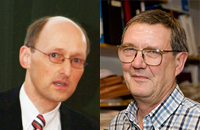Lectures April 9th (10-12 AM) Hendrik Fuchs and Michael Hamblin

In connection with the dissertation of Maria Berstad, Professor Hendrik Fuchs, The Molekulare Krebsforschungszentrum of the Charité MKFZ, Berlin and Professor Michael Hamblin, Massachusetts General Hospital, Havard Medical School will present two lectures from 10-12 AM Thursday April 9th in the Auditorium at the Research Building, Institute for Cancer Research, Montebello. Everyone is welcome.
10.00 am : Professor Hendrik Fuchs, Charité - Universitätsmedizin Berlin
Glycosylated Triterpenoids as Mediators for an Enhanced Endosomal Escape of Protein-Based Anti-Tumor Drugs
Protein-based targeted toxins gain more and more importance in the development of new anti-tumor drugs. Since the activity of targeted toxins takes place in the cytosol of tumor cells, they will only be effective when they escape from endosomes or lysosomes, however, this process is very inefficient. Therefore, new strategies that help to enhance the endosomal escape are urgently required. We identified particular glycosylated triterpenoids, e.g. SO1861, that specifically mediate the release of certain ribosome-inactivating proteins (RIPs) out of endosomes and lysosomes into the cytosol without affecting the integrity of the plasma membrane. Further studies revealed that endosomal/lysosomal acidification is a prerequisite for the SO1861-mediated release of RIPs. Binding analyses demonstrated an association of effective glycosylated triterpenoids with RIPs in a pH-dependent manner. The applicability of the SO1861-mediated effect was demonstrated in vivo in a syngeneic and a xenograft tumor model using a targeted anti-tumor toxin consisting of the epidermal growth factor as targeting moiety and either saporin or dianthin as toxic proteins. Dependent on the model and toxin an average tumor regression between 87% and more than 95% (p < 0.05) was observed with complete response in most individuals. It is notable that only 0.1 µg to 0.35 µg of the targeted toxin per treatment was required for the observed effect whereas 5.0 µg per treatment was necessary for saporin-EGF in the absence of SO1861 to obtain a regression of only 33%. In vitro experiments showed that this strategy can also be successfully applied for existing antibodies such as cetuximab and trastuzumab while retaining antibody-dependent cell-mediated cytotoxicity. Therefore, the SO1861 shuttle system is a promising strategy for effective cytosolic drug delivery.
Home page Professor Fuchs research group
11.00 am: Professor Michael Hamblin, Massachusetts General Hospital, Harvard Medical School
Stimulation of anti-tumor immune response after photodynamic therapy for cancer.
Photodynamic therapy (PDT) has been used as a cancer therapy for forty years but has not yet advanced to a mainstream cancer treatment. Although PDT has been shown to be an efficient photochemical way to destroy local tumors by a combination of non-toxic dyes and harmless visible light producing reactive oxygen species, it is its additional effects in mediating the stimulation of the host immune system that gives PDT a great potential to become more widely used as a cancer therapy. Although the stimulation of tumor-specific cytotoxic T-cells that can destroy distant tumor deposits after PDT has been reported in some animal models, it still remains the exception rather than the rule. This realization has prompted investigations to test various combination approaches that could potentiate the immune recognition of tumor antigens that have been released after PDT. Some of these combination approaches use immunostimulants including various microbial preparations that activate Toll-like receptors and other receptors for pathogen associated molecular patterns. Other approaches use cytokines and growth factors whether directly administered or genetically encoded. Other promising approaches involve depletion of regulatory T-cells and reversal of epigenetic gene silencing. We believe that by understanding the specific methods employed by individual tumors to evade the immune response and taking measures to neutralize them, more precise ways of potentiating PDT-induced immunity can be devised.
Home page Professor Hamblin`s research group
